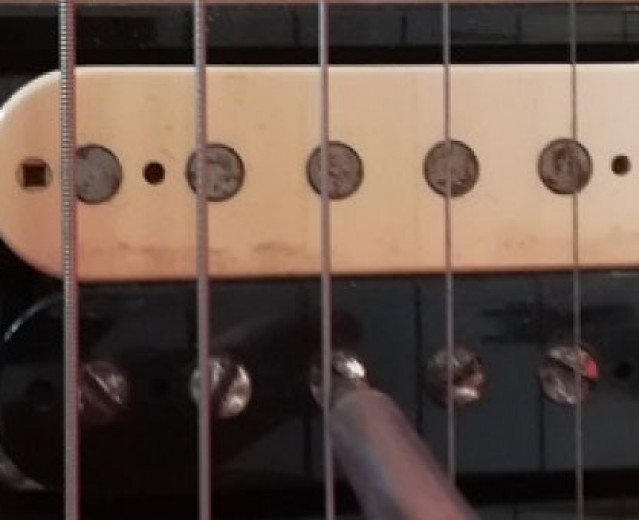How to adjust the distance of a
humbucking pickup from guitar strings.
In this article you will find instructions and tips about pickup height setting on electric guitars, with special regard to humbucking models. Another article of this blog deals with single-coil pickups. This is part of the general setup of the guitar, that involves topics covered on the Soundsation blog as neck truss-rod and action adjustments.
Before continuing you should
have:
All that verified, we can talk about
how to self-adjust humbucking pickups working on their mounting screws on frame
or guitar body.
Magnets and coils
An electric guitar pickup is an electro-magnetic
transducer that converts string vibration into an electric signal. Easier
said, it is a set consisting in coils of isolated electric wire, magnets (permanent
magnets made of magnetizable materials as Iron, Nickel and Cobalt),
pole pieces and an enclosure.
An electro-magnetic field surrounds the pickup
magnet and electrical particles move from the North pole to the South pole
of it. When this field is disturbed by string movements (strings must be
made of metal to interact), an electrical voltage is induced and it varies
as the string vibrations change. This variable electric signal reaches the
guitar jack output through the coil, volume and tone potentiometers, and then it is
send to the amplifier to be amplified and converted into sound waves.
It can therefore be understood that string-pickup
interaction has a lot to do with their distance, in addition to
the electro-magnetic field strength and shape.
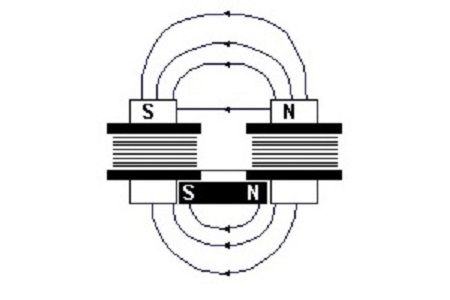
Common pickup magnets are made of Alnico
(Aluminium, Nickel, Cobalt and Iron) in its different classifications (2, 3, 4,
5) or ceramic (Iron oxide powder and Barium or Strontium carbonate ceramic),
also called ferrite, more fragile but cheaper. Ceramic magnets can be
recognised at sight thanks to their dark colour, whereas Alnico is shiny. Some
magnets are produced with the contribution of alternative materials, as Rare
Earth elements Neodymium and Samarium.
How is a humbucking pickup made?
In our blog article about single-coil pickups, I
explain they are based on a single coil of isolated electrical wire and one or
more magnets. They are easily liable to picking up noise, particularly
hum from household electrical wiring (230V 50Hz or 120V 60Hz according to
countries).
This problem was solved by means of the humbucking
pickup in the '50s, though it had been already studied since the '30s
(Electro-Voice, Baldwin, Rickenbacker, Vega). In 1954 technician Seth Lover
– who had found a solution to hum in amplifiers – started working on a
hum-bucking pickup for Gibson electric guitars. The result was the renowned
P.A.F. (initially featuring fixed poles and named PU 490), for which Gibson
requested a patent in 1955 – as it is well known, the “P.A.F.” writing on the
label means “Patent Applied For”. However sales proposal started only in 1957.
At the same time technician and accordionist Ray Butts was working at
the Filter'Tron humbucking pickup for Gretsch. A patent was also requested for
this pickup in 1957, so this was a “Patent Applied For” too.
The solution offered by the new Gibson humbucking
pickup consists in using two wire coils – rather than one – connected in
series, in electric and magnetic phase opposition (opposed poles and coils).
Interference caused by lights and transformers is virtually cancelled by coil
combination. In this process some frequencies are lost, causing the typical
less brilliant and warmer sound of humbuckers as compared to single-coils.
Using two coils also provide a higher output level.
Humbucking pickup types
Humbucking pickups can be of the following kinds:
- two side by side
coils (large
humbucker), as the ancestor Gibson P.A.F.
- Two stacked coils
fitting in a single-coil space as in DiMarzio HS series (stacked humbucker)
and Kingmans
- In both described
cases, magnets have bar shapes and are placed under the coils. The
screws or cylinders or blades going through the coils are pole pieces, but
there are few large humbuckers with twelve real cylinder magnets (old Schecter
Super Rock)
- Another kind of
humbucking pickup in a single-coil size features two narrow coils placed side
by side and screws or blades as poles (rail humbucker)
- Some humbuckers may
have screw poles on a side and a blade on the other (DiMarzio Megadrive)
whereas mini-humbuckers feature two magnets inserted into the coils (Gibson
Firebird)
- In the mid '70s active
pickups also appeared (EMG and other brands afterwards). They are equipped
with a built-in low impedance preamplifier, are efficient and silent,
but a 9V battery is needed.
Starting from these general
categories, through the decades we have seen any kind of attempts, mixing
coils, magnets, poles and so on. CNC machinery is capable of making very
compact windings with extremely thin wire for productions that were
unworkable in the '50s and '60s. For more reference, there are excellent
books about pickups and their evolution (*).
Adjusting humbucking pickups
It can seem strange to many, but humbucker setting –
it doesn't matter if they are large or narrow – is mainly an ear guided
operation! Manufacturers have their specifications about pickup pole
distance from strings, usually referring to the 1st and 6th
strings. For example, in the case of a Gibson pickup, leave each screw pole in
the factory position, press the 6th string at the last fret and start
distancing the bridge pickup at about 1,5 mm from strings and the neck one at
about 2,5 mm, roughly builder's current indications.
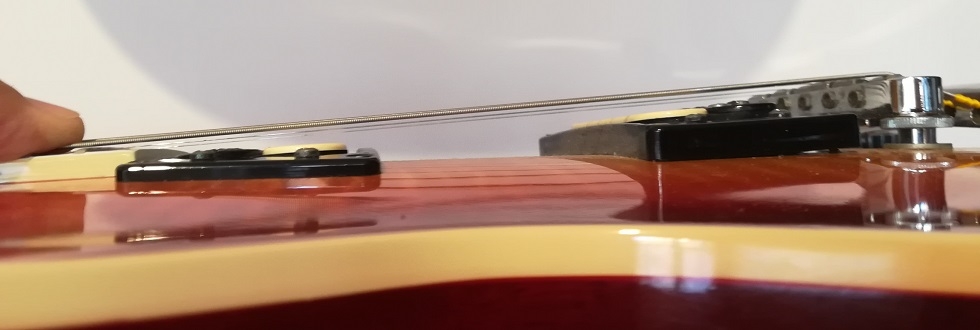
Don't worry about precision and start listening to
open string sounds. Leave the string, lower the bridge pickup just a bit – a
quarter or a half of turn normally produce perceivable changes – and consider
the sound: is it thicker or thinner? Has it more or less harmonics? Is it
more brilliant or deeper? Is it airy or compressed? Clear or hazy?
Stay on the bridge pickup and carry on by attempts,
generally lowering just a little the pickup and listening to the result. At
some point you'll feel the sound is becoming too acoustic or subtle or
undefined; then go back and raise it until you reach a point the sound seems right.
Some experts use to say in focus sound,
because you are in fact adjusting the interaction between the
electro-magnetic field and the string vibrations as you were focusing a subject in an optical
lens.
This way of setting a pickup height only
applies to your specific instrument with that pickup, those strings, based on
your essential taste and well trained ear.

Let's go to the neck pickup
Sometimes, even on pros' guitars, it
happens to see humbuckers that are almost sticked to the strings,
searching for a more powerful and deeper sound. Actually a fundamental
pushed sound with little sustain is obtained, since string vibration is
limited by the pickup magnetic pull.
Once you have set the toughest pickup, the
bridge one, you can handle the neck pickup, that always gives a louder and
fatter sound, because of its position where string vibration is broader. You
have to lower the pickup just enough to get a sound that matches the bridge
pickup in volume. Moving the switch from a pickup to the other, you should
not hear big level differences. It doesn't matter if the neck pickup seems very
far from strings as compared to the bridge one.
Once you have finished this process, it is time for a
more specialized adjustment, searching for the optimal focus of the neck
pickup too.
What about if pickups were three, as in SG Custom style guitars? The method is the same.
Personally, I always start with the bridge pickup, then go on to the neck one
and complete with the middle pickup.
Refinements
The described adjusting method is good for
those with a certain experience. If you feel you are not able to follow
it, manufacturer's specs can be taken for granted. Turning to a luthier or a
skilled technician is always advisable.
Sometimes you can get unexpected
reactions. If you want more bass, do not raise the pickup at the wound string
side, instead lower it at the treble side; and vice versa.
A proof of successful setting comes from
listening to the switch middle positions: if the sound is not typical and
pleasant, you'll have to review something at least for one of the pickups.
If the pickups are very different from
each other, by example if the bridge pickup is a lot more powerful than the neck and middle ones, you'll have to turn to
splittable pickups or accept some compromise solutions: an audible difference
of volume or some drive sacrifice in the most powerful.
Setting very powerful humbuckers can require a little
less care, because the pickup sound often prevails on the guitar character,
though some designs allow a reasonable magnetic flux restraint. If the coils
are mighty indeed (resistance of windings over 12-13 kOhm), it will be
difficult to get more highs than those the pickup make permits. It is
recommended not to get so close to strings.
String alignment
Once a coarse humbucker adjustment has been done,
there are few things to be considered: alignment to strings and screw
pole pieces.
Large humbucker and soap-bar style pickups should
maintain a parallel alignment to strings. That's OK, but parallel to what? To
open or fretted strings? And at which fret? Here is the approximation inherent
to guitar again. Let's take as prevalent an open string parallel alignment.
If the pickup has just two frame screws, we may have to remove it and put some
filling material in the hole. Usually little foam pieces are used,
arranging them to favour the desired placement.

I think that three screw frames are perfect for
this setting and should be adopted universally, except for vintage replicas.
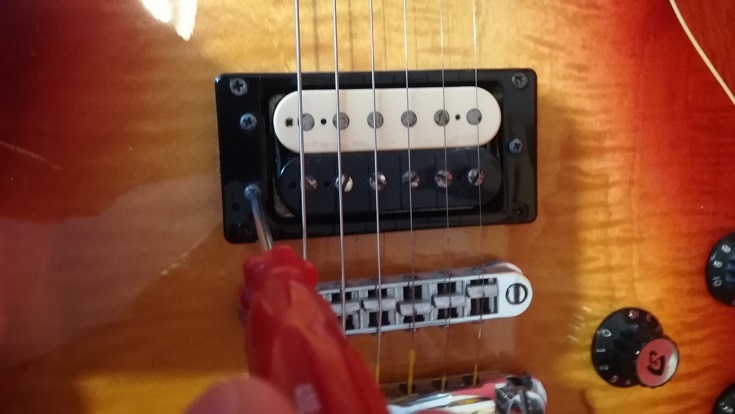
Not everybody likes a parallel profile. If you want a less humbucker-ish character with a hint of single-coil sound, let the
pickup a little tilted towards one of the coils. Which one? It depends on coil kinds: let your ear be the judge!
It is possible that something changes when
you switch from clean sounds to saturated sounds; there is nothing wrong
with retouching pickup setting while an overdrive pedal is turned on.
Poles and pole pieces
Humbuckers mostly have six fixed pole pieces and six
adjustable screw pole pieces, that can be slotted or Allen type. Adjustable
screws help to balance string to string sound level if volume
differences are accentuated.
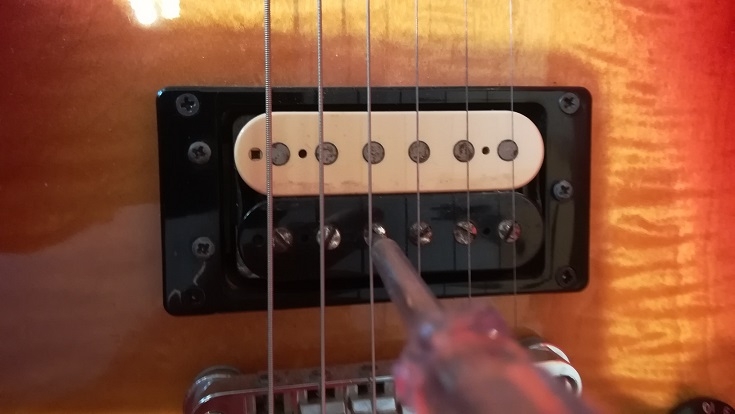
Play, listen, evaluate and screw or unscrew pole pieces till the strings produce the same volume. Start from screw factory setting and try to follow the fretboard and bridge radius; this normally works.
If magnets or poles are exposed blades, there is no
problem: usually they are so powerful that certain nuances became negligible.
And what if the adjustable screws are six per coil, so
twelve in all? Well, start working and good luck!
Fabrizio Dadò
(*)
M.Milan, Pickups - Centerstream Publishing, 2007
M.Milan/J.Finnerty,
The Gibson “P.A.F.” Humbucking Pickup - Centerstream Publishing, 2018.
